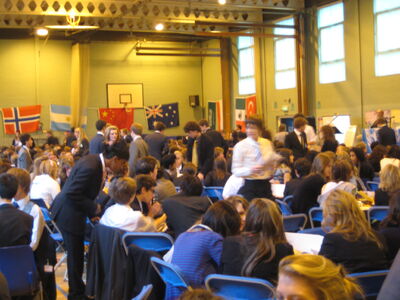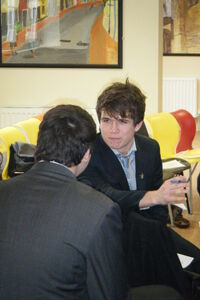
In a Model United Nations Conference, the delegates use Lobbying to gather support for their ideas.
In essence, Lobbying is when you ask other Delegates to disrupt committee and support your resolution or amendment. Lobbying is an essential part of many parliamentary processes. Before the meetings take place, delegates support is arranged, bartered for, and occasionally bought. This has traditionally taken place “in the lobby” – hence its name – but in Model United Nations, Lobbying takes on the formal role as small group discussions that take place prior to a debate.
During Lobbying, students will have the opportunity to take their resolutions to other delegates and try and gain support for their ideas. Delegates have the option to modify their resolution at the suggestion of others, or merge resolutions if they find another delegate with a very similar proposal. Lobbying takes place in the individual committee rooms, which means that a student will be placed amongst a group of other delegates working on the same issues on the same theme (e.g. the Environment).
This also provides a chance for students to “break the ice” and meet the other delegates from other schools. They should aim to locate and get to know their potential allies, and identify those who share their goals.
In the case of school based “mock debates”, informal Lobbying can take place at any time leading up to the session. It is recommended that as well as the student presenting the resolution, one other speaker for and two speakers against are identified before the session (either by the Adviser or the designated Chair) in order to facilitate debate. These four students then have the chance to rally support before their turn to speak. This will, in turn, equip them better to deal with questions and other issues that arise as they will have had the chance to discuss their thoughts and voice their concerns before even arriving at the MUN meeting.
Lobbying Rules

Delegates lobbying at a MUN conference.
Obviously, the formal "rules" of Lobbying differ from conference to conference, and from country to country, but there are a few standard guidelines that most hosts may chose to follow.
At a conference, a delegate’s resolution must be supported by a number of other delegates (usually between 8 and 15 others) in order for it to move on to the next stage. In order to demonstrate and guarantee their support, the delegate will sign the resolution. Conferences usually have subsidiary rules to this, along the lines of, “delegates can only sign three resolutions,” and “a resolution can be signed by at most two delegates from the same school”.
In most conferences, delegates are not permitted to vote against resolutions that they have signed, unless the resolution has undergone any changes (e.g. being merged with another resolution or been amended during debate), although it is expected that delegates will support the resolution wholeheartedly if they choose to be one of its signatories.
Merging
At conferences, delegates may find that another student has prepared a very similar resolution to their own. In such a case, there is the option to merge the resolutions and as such carry the support of both sets of signatories. Computer facilities are often on hand to facilitate the merger, in which a new resolution is produced, formed by clauses from both resolutions. Usually one delegate will remain as the submitter, and the other delegate will become a co-submitter.